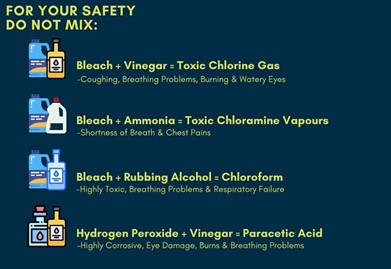Safety Plan – Communicable Diseases
The purpose of this document is to provide you with the appropriate information and procedures to prevent and reduce the spread of Communicable Diseases in the workplace. We have put these measures in place to create a safe workplace for our employees and our customers. This is intended to be a guide to assist you and your fellow team members in following policies and Standard Operating Procedures (SOP) designed to minimize the risks associated with communicable diseases such as COVID-19, Norovirus, Seasonal Influenza and others.
Please speak with the Store Manager if you have any questions or concerns.
Spread of Communicable Diseases
As an employer, we have a responsibility to implement and maintain certain measures, practices and policies to reduce the risk of Communicable Diseases in the workplace.
We are required to:
- Monitor and review communicable disease related information issued by WorkSafeBC, Interior Health or the Provincial Health Officer.
- Implement policies to support staff who have symptoms of Communicable Disease.
- Provide hand-hygiene facilities with appropriate supplies and use policies and signage to remind workers to wash their hands regularly and to cover coughs and sneezes.
- Maintain a clean environment through routine cleaning processes appropriate for the workplace.
- Ensure that building ventilation is adequate, and systems are properly maintained.
- Support employees in receiving vaccinations for vaccine-preventable conditions.
In addition, when advised by Public Health and during a period of elevated risk, we must:
- Follow the directions from medical health officers and the regional health authority.
- Follow all orders, guidance, recommendations and notices issued by the provincial health officer.
- Reassess policies and practices based on updated guidance from regional or provincial health authorities.
Communicable Diseases are most commonly spread from an infected person through:
- Respiratory droplets when you cough or sneeze.
- Close personal contact, such as touching or shaking hands.
- Touching something with a virus on it, then touching your eyes, nose or mouth before washing your hands.
- Contact with blood or other bodily fluids which may transfer disease through cuts or other openings in the skin, transfer to the eyes, nose or mouth.
Prevention of Communicable Diseases
The best way to prevent the spread of infection is to:
- Stay home if you are sick (fever or chills, coughing, diarrhea) to avoid spreading illness to others.
- Wash your hands often with soap and water for at least 20 seconds.
- Avoid touching your eyes, nose or mouth, especially with unwashed hands.
- Avoid close contact with people displaying symptoms of respiratory illnesses.
- When coughing or sneezing:
- Cover your mouth and nose with your arm or tissues to reduce the spread of germs..
- Immediately dispose of any tissues you have used into the garbage as soon as possible and wash your hands afterwards.
- Clean and disinfect frequently touched objects and surfaces, such as electronic devices and doorknobs.
Communications
When appropriate, communications to employees with respect to the prevention of Communicable Diseases are posted on the Health and Safety communications bulletin board and in each department. Employees are responsible to read and understand such communications.
From time to time, through daily huddles and department meetings, managers are to communicate to employees and remind them of the safety protocols put in place to prevent the transmission of Communicable Diseases. Primary focus should be on the need to not come to work when sick.
In the event that the company is notified of an exposure to a Communicable Disease in the workplace, all team members potentially affected by that notification will be provided with appropriate information and directions according to the guidance of the local Health Authority. In all cases, the company will comply with all privacy laws and will provide information to the best of its ability, in compliance with the directions of the Health Authority and respecting all applicable privacy laws.
The Joint Occupational Health and Safety Committee has a responsibility to review and advise BBVG management and employees on safety plans, protocols and measures relating to the safety of the workplace and is consulted on and contributes to the Communicable Diseases Safety Plan, which may be revised or updated from time to time as necessary.
Hand Hygiene
Employees must wash or sanitize their hands on a regular basis. It is recommended that employees wash their hands at least every 20 minutes, for a minimum of 20 seconds. Hand sanitizer stations have been placed around the store for team member and customer use.
Hand washing signs will be displayed in washrooms and lunchrooms for employee and customer reference.
Sick Policy
Employees are required to stay home if they are feeling ill. All employees, including part-time, are entitled to three paid sick days per year under the BC Employment Standards Act when sick with COVID-19.
Training
Employees are provided with communication and training surrounding safe work practices generally, including this Communicable Disease policy and are encouraged to ask questions and provide feedback to managers.
Masks
It has become common practice for individuals to wear a face mask or other face covering during outbreaks or even individual presentations of Communicable Disease. This is a personal choice. Effective July 1, 2021, the wearing of face masks is no longer mandatory, though it remains recommended for those that have not been fully vaccinated. No employee or customer should be challenged for not wearing a face mask and at the same time requests by employees or customers to wear a mask when physical distancing cannot be maintained should be respected.
Importance of Proper Mask Use
If an employee chooses to wear a face mask, it is important that the wearing of the mask is done correctly. Improper donning and removal of a face mask creates greater risk of infection.
Disposable face masks should be used once and then thrown in the trash. You also remove and replace masks when they become moist.
Always follow product instructions on use and storage of the mask, and procedures for how to put on and remove a mask.
Cleaning and Disinfecting Policy
Part of our role in keeping our customers and employees healthy and safe means that routine cleaning and disinfecting is of great importance. This recommendation document is intended to provide guidance for our routine cleaning and disinfecting, highlight the difference between the meaning of cleaning and the meaning of disinfecting, and reinforce the need for appropriate protective gear while cleaning and disinfecting.
Communicable Disease safety measures that need to be in place include:
- Cleaning and disinfection of highly touched surfaces.
- Frequent hand-washing.
- Providing hand hygiene options for customers.
Frequency of Cleaning and Disinfecting Required:
Cleaning and Disinfecting of all high contact areas is required at least once every four hours.
A High Touch Cleaning and Disinfecting checklist has been created for documenting and tracking that cleaning and disinfecting is performed at least every four hours. It is laminated and posted for daily completion and reuse the next day. Please refer to Physical Distancing & Sanitation policy for specific protocol at checkouts.
High contact areas on the checklist include:
- All door handles, including all entrance, exit, cooler, freezer and container handles, throughout the premises, as well as swing door surfaces.
- Deli surfaces, including the service counter, tables and prep areas.
- PIN pads, cheque stands, tops of cash lanes, scanners, till keyboards, and all surfaces at checkouts.
- All shopping cart and basket handles.
- Computer keyboards, mice, and areas surrounding workstation surfaces.
- Phones.
- Communication book areas.
- All washroom surfaces and ensuring adequate supply of hand soap is available.
- Employee break room surfaces.
- Trash receptacle touch points.
In addition to cleaning, deep cleaning is conducted by employees before every store opening and after every store closing.
Cleaning Products:
Cleaning products are products that remove germs, dirt, and impurities from surfaces by using soap (or detergent) and water. Cleaning does not necessarily kill germs, but by removing them, it lowers their numbers and the risk of spreading infection. Hard surfaces should be cleaned using regular surface cleaning products or soap and water prior to disinfection.
Read and follow manufacturer’s instructions for safe use of cleaning products. It is mandatory to wear gloves while cleaning and to wash hands with soap and water for a minimum of 20 seconds immediately on glove removal.
Disinfecting Products:
Disinfecting products (store-bought disinfectant solutions and/or sprays) kill germs on surfaces using chemicals. Read and follow manufacturer’s instructions for safe use of disinfection products (use in well-ventilated areas, allow enough contact time for disinfectant to kill germs based on the product being used). It is mandatory to wear gloves while disinfecting and to wash hands with soap and water for a minimum of 20 seconds immediately on glove removal.
Sanitization of Carts & Baskets:
- All used baskets are to be taken to a designated area in store to be sanitized prior to future use.
- Once sanitized, baskets can be returned to stands.
- Carts are to be sanitized at minimum, every 30 minutes, including handles and baskets.
Right to Refuse Unsafe Work
If an employee has reasonable cause to believe that to carry out any work process would create an undue hazard to the health and safety of any person, they have the right to refuse such action.
The employee must immediately report the circumstances of the unsafe condition or matter to their supervisor. The supervisor receiving the report must investigate the concern and:
- Ensure that any unsafe condition is remedied, or;
- If in the supervisor’s reasonable opinion, it is determined that the report of unsafe conditions is not valid, inform the team member that made the report.
If this does not resolve the matter and the employee continues to refuse to carry out a work process, the supervisor must further investigate the matter. the investigation must be carried out in the presence of the employee that made the report and:
- An employee representative of the JOHSC, or;
- Any other reasonably available employee selected by the employee who made the report.
If this does not resolve the matter, and the employee continues to refuse to carry out the work process, both the supervisor and employee should contact the Health & Safety Advisor, Brenda Szlabon, who will investigate the matter and take whatever actions are necessary. If the issue is still not resolved, WorkSafeBC will be contacted.
No employee is to be disciplined for acting in compliance with these steps. Temporary assignment to alternative work at no loss in pay to the employee until the matter is resolved is not considered to be disciplinary action.


